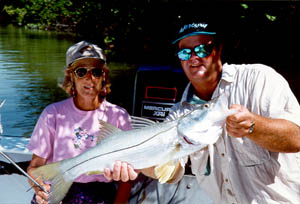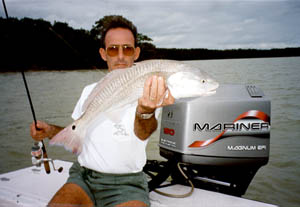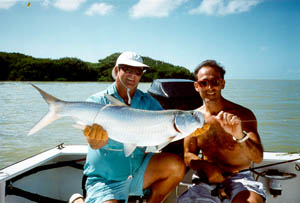 Part of the
Part of theFISHING THE FLORIDA KEYS
Series
Fishing in Everglades
National Park
 Part of the
Part of the
FISHING
THE FLORIDA KEYS
Series
 What do you get when you combine a fun-filled day of fishing with
calm waters, beautiful scenery, and plentiful bird and animal life? Just another day
in Everglades National Park, that's what! With over 75 miles of wilderness
coastline, this truly special place runs west from the bay side of Key Largo, wraps around
the southwest corner of the Florida mainland, and then stretches north all the way to
Everglades City.
What do you get when you combine a fun-filled day of fishing with
calm waters, beautiful scenery, and plentiful bird and animal life? Just another day
in Everglades National Park, that's what! With over 75 miles of wilderness
coastline, this truly special place runs west from the bay side of Key Largo, wraps around
the southwest corner of the Florida mainland, and then stretches north all the way to
Everglades City.
But there's more to the Park that just its
mainland shoreline. Not only is most of Florida Bay to the east of Long Key within the
boundary of the Park, but also as one heads "inside" up innumerable creeks and
rivers into the many brackish-water lakes and bays, it doesn't take long to realize
that this 1.5 million acre Park is as vast as it is unique.
Yet, so much of this watery wilderness wonderland is easily accessible from the Keys.
Flamingo, though located on the southern edge of the Florida mainland, is less than
an hours' run by skiff from Islamorada, and only slightly more from the eastern end of
greater Marathon. Far from the isolated, barely accessible town it once was,
Flamingo is the hub of most of the activity that takes place in the southern half of the
Park. And with the recent explosion in ecotourism, Flamingo is not only popular
among fishermen, but also with those wanting to get in touch with nature as well. A
visitor's center, restaurant, motel, campground, and marina are among the available
amenities.
In terms of fishing, there is literally something for everyone in the Park. From the
delicate art of sight casting, to angler-friendly methods such as bottom fishing or
drifting a bait under a cork, it's possible to find a type of fishing to match the skill
level of every fisherman. Before we overview what the Park has to offer, there are a
few terms an angler ought to be familiar with:
"Outside"- This term describes the waters of the
Park within Florida Bay. It also includes the shoreline of the Florida mainland, and
the beaches at Cape Sable.
" Inside"- Though often used to describe the
general area of Whitewater Bay and its connecting, waters, this term generally denotes
waters such as creeks, rivers, bays, lakes, etc . located within the confines of the
mainland.
The "Plug"- Not a type of fishing lure, but rather
the term describing the man-made barrier (located at Flamingo) separating the
"outside" waters of Florida Bay with the "inside" waters leading into
Whitewater Bay. A mechanical hoist operates from 8 AM to 5 PM (for a small fee) to
haul boats from one side of the plug to the other.
"Lake"- Interchangeable with the word basin, lake
often refers to an area of relatively deeper water surrounded by flats, islands (keys) or
a combination of the two. Most lakes in the Park are about 3-5 feet deep. Lake
can also be used in the traditional sense to refer to an inland body of water surrounded
by land (but in this case, accessible by creek or canal, ie: Bear Lake,Gator Lake, Lake
Ingraham, etc.)
TYPES OF FISHING
 Perhaps the easiest
fishing to get started with (and the most popular) is just general "potluck"
fishing. Drift fishing is usually employed in a channel, a lake, or along the edge of a
flat. Once fish are located, the anchor is usually dropped (or the boat is staked
out for those using a pushpole).
Perhaps the easiest
fishing to get started with (and the most popular) is just general "potluck"
fishing. Drift fishing is usually employed in a channel, a lake, or along the edge of a
flat. Once fish are located, the anchor is usually dropped (or the boat is staked
out for those using a pushpole).
An 8 to 10 pound spinning outfit and a shrimp-tipped jig is a hard combination to beat for this style of fishing. Jigging not only allow an angler to cover more territory, but also will help him to avoid some of those pesky catfish that would otherwise be a nuisance to the bottom fisherman.
The list of available species for this
technique includes snook, redfish, seatrout, sheephead, black drum, mangrove snapper,
jack, and ladyfish. Those specifically targeting trout often attach a popping cork 2
to 3 feet above their bait or jig...a soft yank of the rod produces a "plunk" on
the water that compels a trout to investigate. The use of a popping cork is
especially effective in murky water.
Another type of fishing that is particularly attractive to experienced anglers is that
sightcasting from a boat being poled across the flats. Nearly any thing that can be
caught in the Park has been caught on the flats at one time or another. This is
especially true when casting into "muds" caused by either stingrays or a school
of mullet...gamefish looking for an easy meal are often found on the edge of these muds.
Yet, redfish are the most popular target on the flats, and their willingness to hit
a fly makes them a popular target among fly fishermen. For those using spinning
gear, a weedless spoon works well on murky flats, and a live shrimp or a light, weedless
jig woks well in the clear water.
The Park is also a great place to fish for tarpon. "Baby tarpon" in the 5
to10 pound range are frequently found in the narrow creeks throughout the Park. The
big boys like the mouths of some of the larger rivers and canals, and also can be found in
some of the deeper channels that border shallow water.
If you think you'd like the challenge of a shark on light spinning or even fly gear, the
Park is loaded with them, ranging in size from pups to brutes. Lemons are the most
common shark, with shovelnose and blacktip sharks also being frequently caught.
 If you're one who likes to get out of the boat and
roam a desolate shoreline somewhere, then Cape Sable is the place for you. Located
along the southwest shore of mainland Florida, this wonderful spot is literally miles and
miles of sandy beach. Not only is there some good fishing available at times (trout,
redfish, snook, jack, ladyfish, mackerel, and bluefish to name a few), but the beaches
also provide some marvellous shelling opportunities, especially after a hard northwest
wind.
If you're one who likes to get out of the boat and
roam a desolate shoreline somewhere, then Cape Sable is the place for you. Located
along the southwest shore of mainland Florida, this wonderful spot is literally miles and
miles of sandy beach. Not only is there some good fishing available at times (trout,
redfish, snook, jack, ladyfish, mackerel, and bluefish to name a few), but the beaches
also provide some marvellous shelling opportunities, especially after a hard northwest
wind.
And then there's snook fishing. Whether one chooses to call this a sport, a science , a
passion, or even a disease, it is an incurable malady that comes from spending long hours
in the backcountry. Afflicted anglers may chose to either drift live baits (small
mullet or pinfish) in channels, toss plugs or jigs along the edge of a mangrove-lined
shore, or cast a jig or fly to them as they lay in potholes that dot the flats. Some
excellent snook fishing is also available by taking a trip over the "plug" at
Flamingo and up into Whitewater Bay.
CAVEATS
There are a few caveats to consider when
fishing the Park. One of them is that the frequently murky water make it difficult
for boaters to "read" the water to determine where the channels are. It's
not an infrequent sight in the Park to see a boat stranded high and dry after it's
operator either ran it aground at high speed, or else miscalculated the speed of a falling
tide while fishing and got stuck. Hopping out of the boat to push it off a flat is
an adventure to the uninitiated...typically one will sink down to the mid thigh region in
water that only appeared ankle deep. The mud that makes up most of the flats in the
Park is soft, sticky, and incredibly smelly. If you see someone back at the dock at
day's end covered with this mud, don't laugh. He has had a very bad day.
Without meaning to sound self serving, you really need the services of an experienced
guide to make the most of your initial trips to this region.
Another caveat is that there are numerous regulations regarding activities such as
boating, fishing , camping, etc. that one must adhere to while in Park waters. A
number of areas are off limits to motorized boat traffic, and there are only a few
locations in which one is allowed to get out of the boat and walk around. Because a
thorough explanation of the Park's regulations is beyond the scope of this article, it is
strongly recommended that you acquire this information before you fish there. The
rangers frequently patrol the Park both by boat and by airplane, and ignorance of the law
will not be tolerated as an excuse. Also, because of the seasonal nature of the
tourist season as it relates to the Park, some of the amenities and services normally
available during the winter months are not available during the summer. Again, it's
always best to know before you go. .
And finally, you'd better be prepared to deal with biting insects, particularly
mosquitoes. Typically, they're not bad from November through March, but they don't
carry calendars either. I like to wear long-sleeved shirts and long pants (and even
socks if you can believe that) any time I'm fishing on the "inside".
Obviously, plenty of repellent is a must, and when you find one that really works well, I
want to know.
The benefits of a day in the Park still far outweigh the difficulties. For one, you
won't have to listen to road traffic or construction or gas-powered yard blowers like you
would on many of the flats bordering the Keys. You also won't have to tolerate the
annoying buzz of jet-skis whipping by and blowing fish off the flats in front you.
The only sounds you are likely to hear is the chatter of bird life, or perhaps the splat
of a mullet as it breaks the surface. Oh yes...you'll have to put up with the
frequent sound of your reel's drag squealing in protest. But I'm willing to bet you
could get used to that!
Whether you are looking for a few pan-sized seatrout to take home for supper, or seeking
the challenge of taking a monster-sized tarpon on fly... or even if you're just wanting to
take in the awesome beauty of this special place, one thing is certain: There is something
for everyone in Everglades National Park!
For more information regarding available activities, regulations,etc., contact:
National Park Service
Everglades National Park
PO Box 279
Homestead, FL 33030
(305) 242-7700
Because the concessions are run by a business entity other than the National Park Service,
the following address may also prove helpful:
Flamingo Lodge, Marina, and Outpost Resort
Flamingo, FL 33034
(305) 253-2241
![]()
About the Author
 Captain Buddy LaPointe is a cum laude
graduate of Pensacola Christian College, and has over 20 years experience charter fishing
in the Florida Keys. He has been featured on Mark Sosin's Saltwater
Journal, (seen weekly on national television), and in the Outdoors section
of the Miami Herald. In addition, Capt. Buddy has written
numerous articles for Sport Fishing Magazine, Saltwater
Sportsman, Fishing the Florida Keys, and the Florida
Keys Keynoter.
Captain Buddy LaPointe is a cum laude
graduate of Pensacola Christian College, and has over 20 years experience charter fishing
in the Florida Keys. He has been featured on Mark Sosin's Saltwater
Journal, (seen weekly on national television), and in the Outdoors section
of the Miami Herald. In addition, Capt. Buddy has written
numerous articles for Sport Fishing Magazine, Saltwater
Sportsman, Fishing the Florida Keys, and the Florida
Keys Keynoter.
![]()
SITE LAST UPDATED 9/9/99
|
HOMEPAGE | ARTICLES | EMAIL/FEEDBACK |